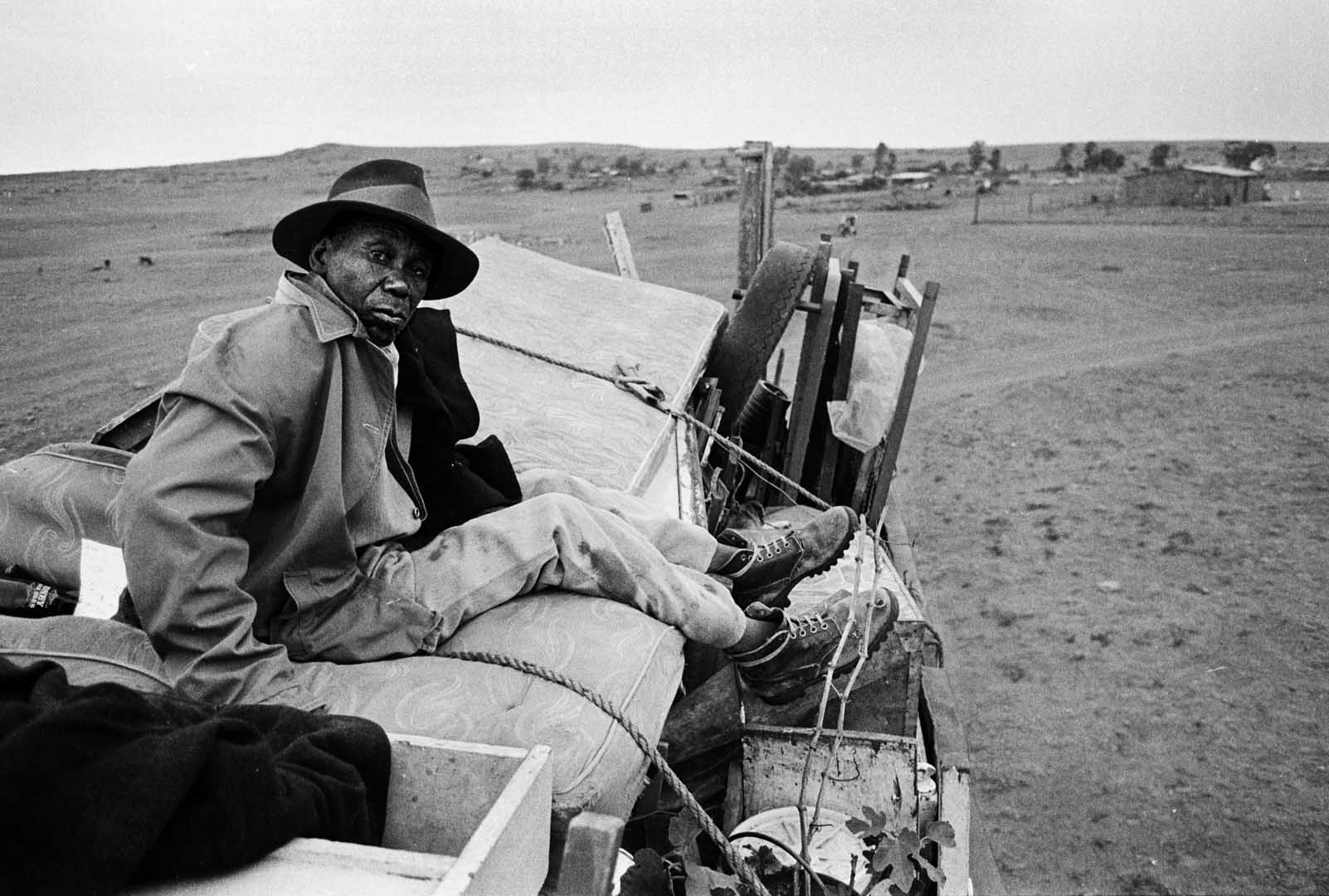
Paul Weinberg. Mogopa Removals, 1984. Archival Digital Print. ©Paul Weinberg, 2019. Courtesy of the artist.
I remember a seminal moment during the turbulent 1980s, when David Goldblatt confided in me. At the time, I was part of a collective of photographers, called Afrapix, that I had co-founded. Without trying, we were at the center of the storm: We photographed the ongoing violence against ordinary black South Africans, who had prepared themselves for continued resistance to the apartheid state. We called ourselves the “Taking Sides” generation and were unashamedly partisan as we recorded the aberrations of South African society and the events as they unfolded.
“Every image that revealed what was happening was a victory against the system.”
David’s disclosure was simple and to the point: despite his considerable reputation as a photographer, he felt his work—at that point in history—was meaningless and of no value. He thought our photographs, on the frontline of political struggle, were more important than his work, which he felt was peripheral. At the time, photojournalism had a particular gravitas. Images were circulated into the national and international news media and, in our case, mainly the alternative press. Njabulo Ndebele, one of South Africa’s finest writers, described David’s paradigm somewhat differently; he saw an evolving tension between the spectacular and the ordinary. The pervasiveness of apartheid, in all its ugly and grotesque manifestations, consumed us. Ndebele pleaded for preserving the sanctity of ordinary people caught up in historical events—who had names, hopes, and dreams—rather than simply reducing them to statistics, lost in the amorphous atrocity.
This ambivalence was not unfamiliar to me. While the frontline was where the camera gravitated, as lines of battle were demarcated in a time of civil war, I was a reluctant war photographer. Like my colleagues in Afrapix, I believed that every image that revealed what was happening was a victory against the system, against myopia, and against national amnesia.
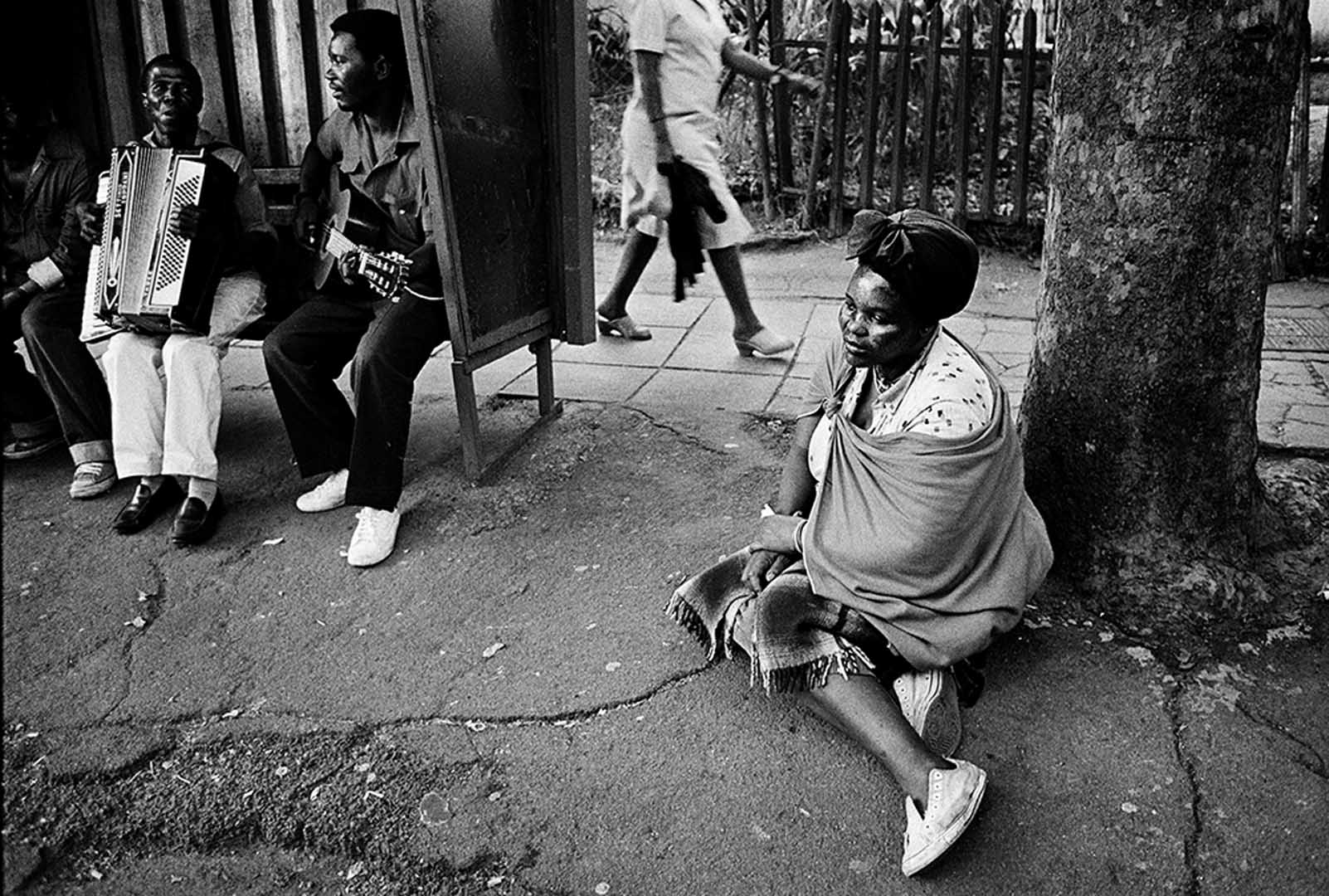
Paul Weinberg. Traveling Light, 1980. Archival Digital Print. ©Paul Weinberg, 2019. Courtesy of the artist.
Ndebele alluded to the invisible landscape that ran through the country. David, a self-described “failed newspaper photographer,” had dedicated his photography to working beyond the headlines, to explore and elevate the lives of ordinary people. David’s confession was also part of my existential dilemna; I too was drawn to this invisible world. As a young photographer, I had spent many years walking the streets of Johannesburg, visiting townships, and celebrating the ordinary. The camera was a way to understand my country and to learn about the world around me, which was cut off by the visible and invisible divides of apartheid. Some of my pursuits crisscrossed, unknowingly, with David’s. We both had photographed in Fietas, a mainly Indian community in the center of Johannesburg that faced displacement because of the Group Areas Act. At first my connection with Fietas was not photographic. I was part of cricket team based there, in a non-racially-specific league. I watched with alarm as my teammates and families lost their houses and were relocated thirty kilometers from the center of the city. I shot photographs and made a documentary film about what was happening. Nearly forty years later, my work sits alongside David’s concerted and thorough work in the Museum in Action, established by Salma Patel in Fietas for the memory of the community.
“Apartheid shadowed me on all these journeys; it was always there, but between the cracks, life continued, with its pain and joy.”
Ironically, my journey into the invisible landscape continued at the height of the struggle against apartheid. I worked in rural areas for human-rights organizations that were doing their best to find legal loopholes to stave off displacements and to support communities. My camera took me to places like Mogopa, two hundred kilometers from Johannesburg, where I witnessed the drama of a once-vibrant farming community, documenting its desperate attempts to stay, its removal to a desolate homeland, and then its post-apartheid return.
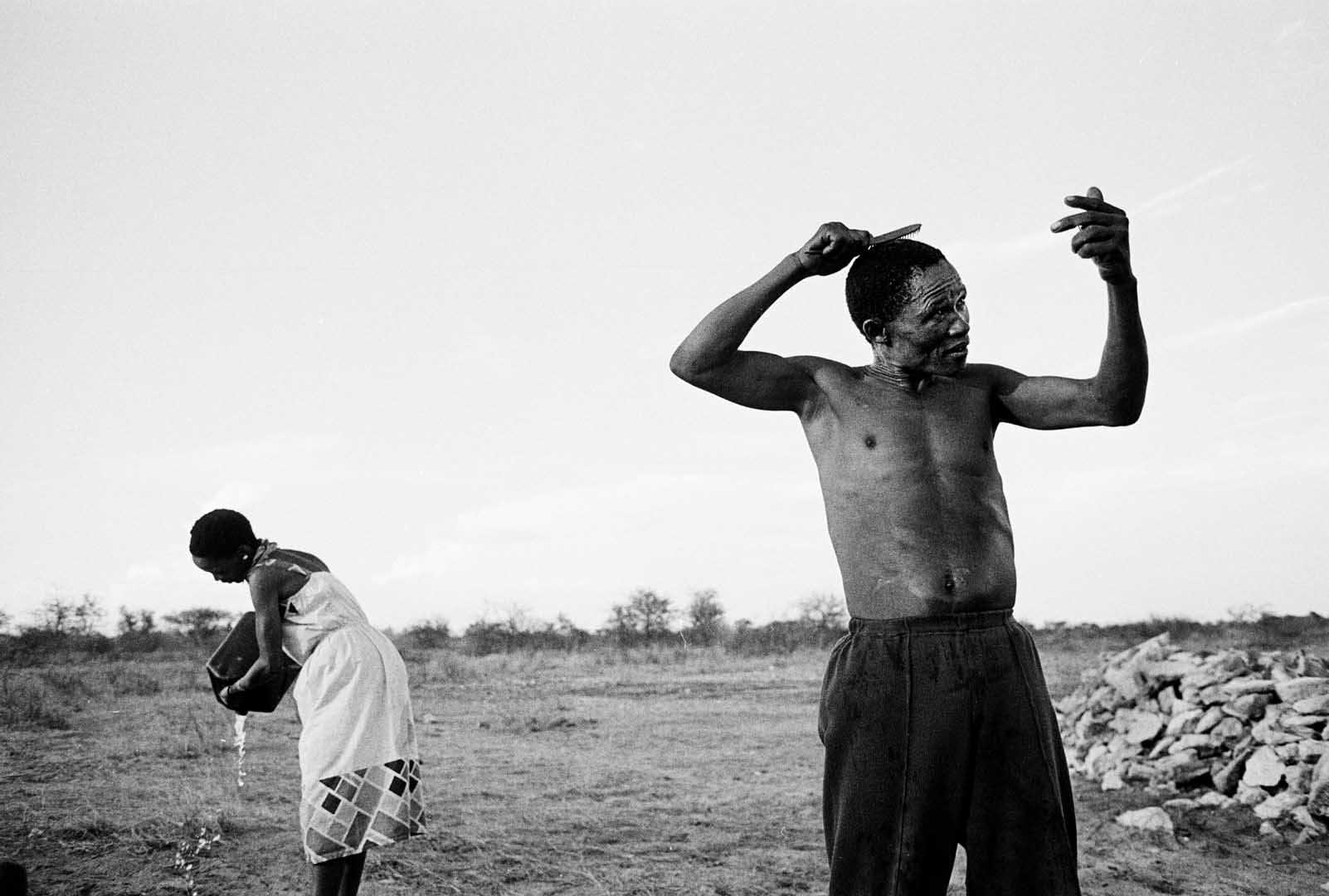
Paul Weinberg. Oma and Xam at dusk, 1989. From the Travelling Light series of the Nyae Nyae San, Nambia. Archival Digital Print. ©Paul Weinberg, Courtesy of the artist.
When I began working with Africa’s first people, the San, I was working against the tide. The San, despite centuries of genocide and dispossession, were presented as people living in some kind of stone-age bliss, in “primitive affluence,” as if time had stood still. Films like The Gods Must be Crazy, numerous advertisements and commercials, and feature stories in magazines perpetuated what renowned the filmmaker John Marshall called “Death by Myth.” The truth was that the San were marginalized and badly treated by white and black farmers alike; even more catastrophic and disruptive was that they had been drafted into the South African army and the Namibian civil war. For thirty years I journeyed with communities throughout southern Africa who struggled to hold onto their lands and a hunter-gatherer way of life, in the rare circumstances in which they could.
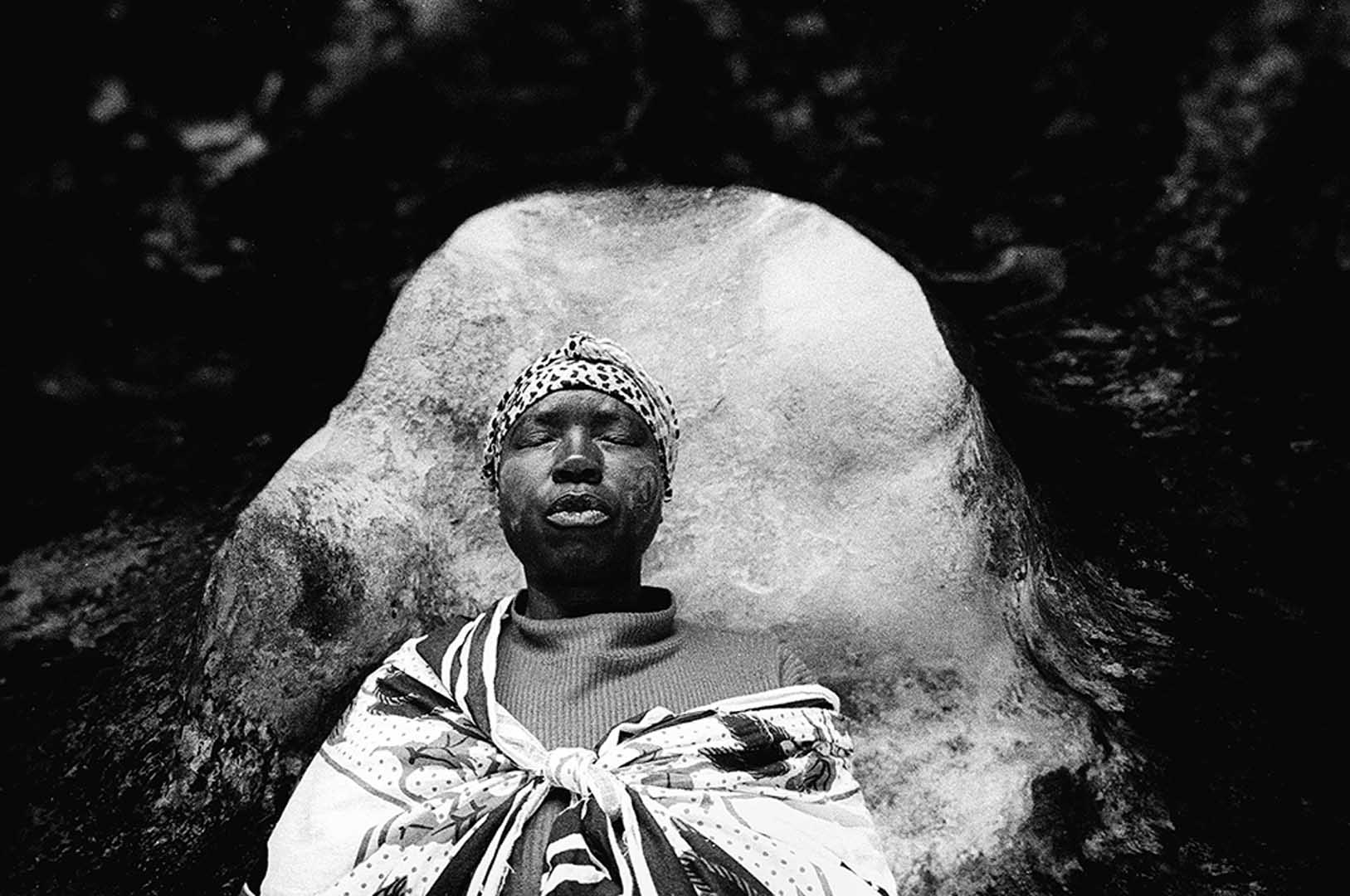
Paul Weinberg. Sangoma Ceremony of the Zion Church, 2002. From the Moving Spirit series. Archival Digital Print. ©Paul Weinberg. Courtesy of the artist.
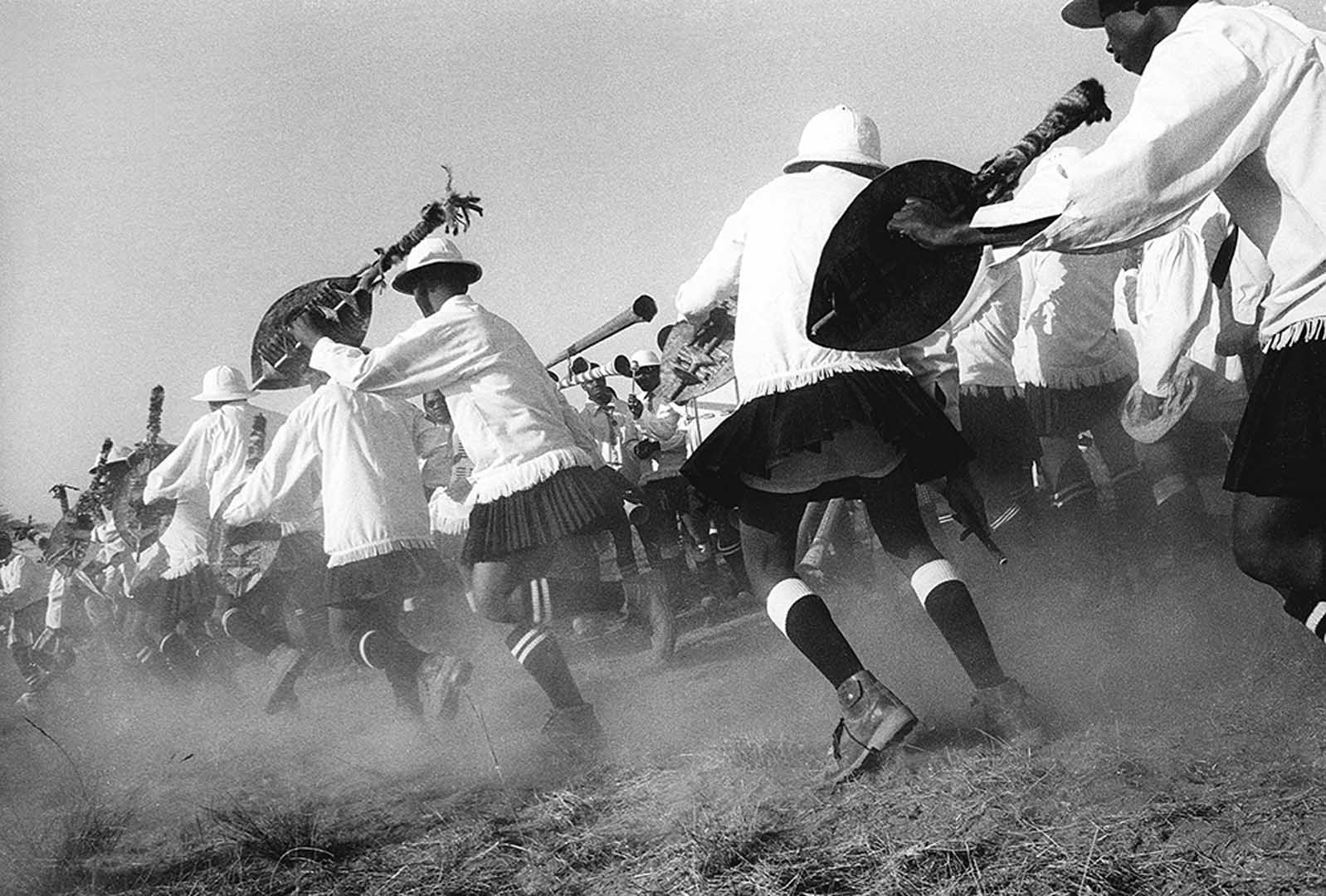
Paul Weinberg. Moving Spirit series, 2000. Dancing the Scotch Dance, during the July Festival, Inanda, Durban, South Africa. Archival Digital Print. ©Paul Weinberg. Courtesy of the artist.
The dawn of the new South Africa, liberated from the manacles of apartheid, elicited new ways of seeing. I reveled in the new freedom to travel, to make visible the invisible landscape: to tell muted, hidden, and personal stories. I spent a decade on a project called Moving Spirit. In a time of national healing, I explored diverse practices of spirituality. I wrote in the project’s book: “I, too, with or without my camera, am part of a country trying to heal. In this journey I join millions of South Africans continuously on a pilgrimage beyond politics and platitudes…in search of the transcendent spirit.”
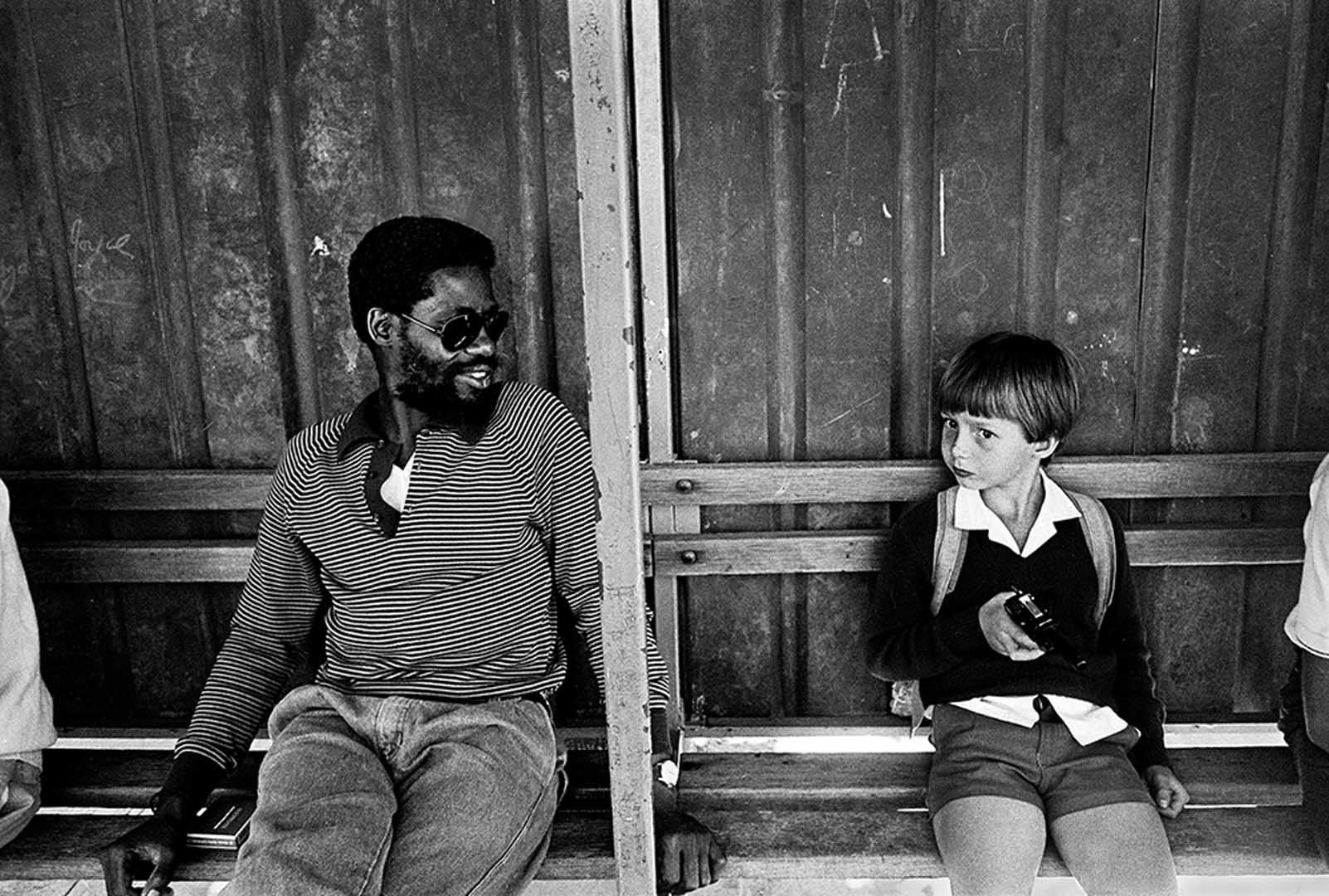
Paul Weinberg. Travelling Light, 1986. Waiting for a bus during apartheid, Pietermaritzburg, South Africa. Archival Digital Print. ©Paul Weinberg, 2019. Courtesy of the artist.
“The ordinary continues to be the metaphor for the country’s soul.”
I composed a series of images that had been buried in my archive; Travelling Light; a celebration of earlier photographs that I excavated from the past, that I had put to the side during the dark days of apartheid, when the spectacular overwhelmed the ordinary. Apartheid shadowed me on all these journeys; it was always there, whether I was conscious of it or not. But between the cracks, life continued, with its pain and joy. The ordinary was mirrored in the lines of people’s faces or in the fascist bravado of military parades. I watched how people reflected themselves, how I absorbed their reflections, how they danced with reality, how they made light in a dark space, and how they embraced each other at great risk.

Paul Weinberg. Travelling Light, 1996. Catching the Quickie, Durban Harbour, South Africa. Archival Digital Print. ©Paul Weinberg, 2019. Courtesy of the artist.
As we gear up to celebrate twenty-five years of our new democracy, there is much to reflect on, for photographers and for society as a whole. The ordinary continues to be the metaphor for the country’s soul. Apartheid has officially disappeared, but its aftereffects and those of the colonial past, remain. Our liberation-movement government has failed and forsaken its people. It is a far cry from the moment of joy and optimism that I experienced when I photographed Nelson Mandela as he voted for the first time, in 1994. Now, thirty percent of the population lives below the poverty line, and many estimate that forty percent is unemployed. We watch one commission after another reveal unbounded corruption, nepotism, and national neglect. But, to guide us in this difficult time, we should hold onto David Goldblatt’s words, from an interview we shared, on a project called Then and Now, reflecting on our work during and after apartheid. They are as relevant and inspirational now as they were during the turbulent 1980s, when he made his confession to me: “During the apartheid years, my primary concern was with values: what our values were, how we had arrived at them, and particularly how we expressed them. And once you start with that line of thinking, there is no break: there is a continuation. I am still concerned with what our values are and how we are expressing them.”



